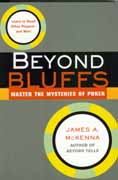
Beyond Bluffs

Poker Books Beyond Bluffs by Mckenna and Ramsey's 'Visual' Guide Helpful
As the never-ending march of poker books for advanced players and absolute beginners continues, two more titles trying to fill an informational space have arrived at Gambler’s Book Shop. Beyond Bluffs by Howard Schwartz, the "librarian for gamblers," is the marketing director for Gambler's Book Club in Las Vegas, a position he has held since 1979. Author of hundreds of articles on gambling, his weekly book reviews appear in numerous publications throughout the gaming industry. Howard's website is www.gamblersbook.com James McKenna (280 pages, paperbound, $15.95) takes top spot along with Dan Ramsey’s Teach Yourself Visually—Poker (290 pages, paperbound, $24.99).
Howard Schwartz, the "librarian for gamblers," is the marketing director for Gambler's Book Club in Las Vegas, a position he has held since 1979. Author of hundreds of articles on gambling, his weekly book reviews appear in numerous publications throughout the gaming industry. Howard's website is www.gamblersbook.com James McKenna (280 pages, paperbound, $15.95) takes top spot along with Dan Ramsey’s Teach Yourself Visually—Poker (290 pages, paperbound, $24.99).
McKenna, whose first book, Beyond Tells gained a solid foothold in 2005, follows up that work with a look at bluffing. A practicing individual and group therapist for more than 30 years, McKenna focus on bluffing as an art and skill in itself eyed to timing and designed to throw opponents off guard and assist even the tightest player in varying his or her play—especially in a tournament situation. With 14 illustrated chapters, a nice, detailed index, the author brings to the surface psychological rationale applied to poker, focusing on a variety of situations where bluffing is vital for survival and often ignored as a tool because of player fears.
McKenna examines how people often react with scared money; player inability to read hands; ignorance of odds; playing too tight or on tilt. He gets down to the nitty-gritty of it all—smart and dumb moves; the difference between a player and a fool and developing the art of understanding how your opponents think.
If you’re new to the game or a rare bluffer, there’s a vital section on how to tell bluffs apart. For example, there are sneak bluffs; dare bluffs; attack bluffs and dream bluffs among others. Then there are what the author calls “bluffs with personality” with responses based on personality predispositions. Plus, he provides a nice look at player perceptions; bluffing styles and traits.
Clearly this book parallels the need for studying various style of acting—looking glum; action-oriented; excited; bored, whatever. It’s going to take practice and discipline. Knowing your own limits or expanding on your ability to silently generate a mood or emotion may be an art in itself. Maybe that’s why Doyle Brunson, the Robert DeNiro of poker, seems to win those extra pots—through practiced, manipulative moves, designed to intimidate or to set up wet-behind-the-ears beginners who got lucky enough to get to the final few tables in a tournament. Then there’s stoic Phil Ivey, tough to read, always focused, rarely on tilt—like a great wall of confidence, always keeping opponents off balance.
Absorb, analyze, apply McKenna’s material. It should help you be a braver bluffer and to teach you why laying a hand down in the right situation can often be as profitable as a raise over the top.
Teach Yourself Visually—Poker is a beautifully-illustrated book—in color, in 10 chapters, some of which may be wasted on those only interested in hold’em.
It still puzzles me why anyone still writes about draw or stud poker in an era where hold’em and Omaha are 1-2 in popularity, but it’s done to grab a wider audience of buyers I suppose.
This is a fine book (although a bit over-priced) for beginners or as a gift for a friend or relative who must be “walked through” everything from what a flush is to table etiquette.
Visually, it’s a beauty. There’s a small section on online and video poker, but the strategies for hold'em are shallow (six pages) with very little rationale—it is like the author wished to clearly avoid any in-depth explanations.
The strength of the book is in its ability to clearly show the rules in a never-ending parade of color illustrations—including Omaha 8 or better split, and for games like razz and pineapple in home games. It’s a relaxing way to learn, and it’s bound to increase the absolute beginner’s level of confidence from point zero to about a three on a scale of 10.
